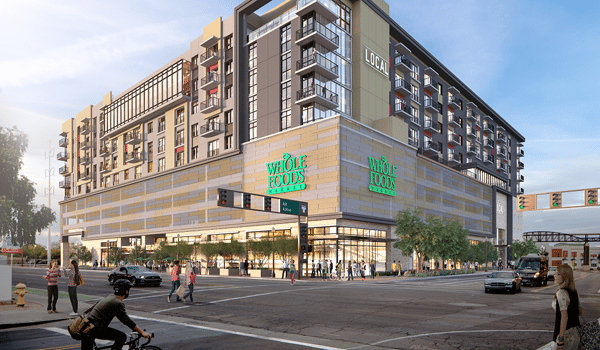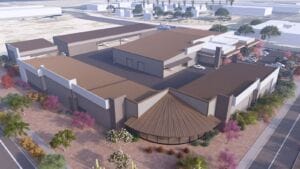They are the leaders of their companies and some of the most knowledgeable men in the business, so why not turn to them for some insight on the state of the commercial construction industry?
These Arizona Builders Alliance members took the time to share their thoughts and visions for the industry and give some advice for the future workforce.
While workforce issues remain a big concern, what other issues are currently affecting the construction industry in Arizona?
Robert F. Hart: Rising Cost of Material, infrastructure and soft costs associated with the development.
Barry Chasse: Project delays are currently affecting the construction industry. Architects and engineering firms have been faced with increased workloads and municipalities with numerous project submittals. The busy market has also caused vendor procurement times to increase due to demand. The market demand has brought in a new and inexperienced workforce which has threatened safety. Experienced tradesmen and superintendents of the baby boomer generation are also nearing retirement. There is also a gap of construction workers due to the recession and limited hiring within the industry. Other areas of impact include threats of tariffs and rapid increase of inflation.
Steve M. Grauer: Price fluctuations and escalations with common building materials (concrete, metals, drywall, piping, etc) are still a big concern in the construction industry. With market uncertainty, commodity products like steel, cooper, aluminum, etc. are changing weekly, which is causing trades to be more conservative and drives the cost of construction, and in turn an owner’s ability to stay within budget. With the labor shortage, base wages continue to increase. Some projects are offering incentives for certain trades to work on their projects.
Ken Kortman: First and foremost, keeping a safe workplace and building a culture around safety, for everyone. We also need every effort made to train the next generation of leadership in order to build and improve upon the great legacy of the construction industry. Certainly being involved with local and national legislative issues, and having a voice of influence to the industry, is vital so that we can continue to provide a pro-business, open competition environment.
Ron Harman: Workforce issues will remain the biggest concern for the construction industry. The lack of drivers is already affecting material costs and delaying the completion of projects. It’s a constant challenge to keep up with the pricing and availability of raw materials and to incorporate that into prices.
Beyond the workforce issues is how companies respond to new health and safety regulations. An example of this is how companies deal with silica dust exposure for their employees. At Coreslab, we have been proactive in implementing enhanced training, monitoring employees’ exposure to silica dust and bringing in new equipment and tools.
How has the industry evolved in the last 10 years since the economic downturn of the late 2000’s?
BC: The industry has become accustomed to running more efficiently and leaner due to companies having to be more competitive in the downturn combined with the shortage of skilled labor and managers as the market increased. The industry is delivering more with fewer resources. The increase of urban development has also changed the market for more dense and complex construction projects.
SG: Only speaking of the Arizona market, Lean Construction has taken a strong hold of the industry and is improving reliable work and helping the craft to trust each other more and building relationships. Prefabrication, kitting and racking of several trades materials together has increased and helped decrease craft in the field and tighten up schedules. With less craft available, these items are helping us do more work with less people. Moving out of what feels comfortable and looking into industry sectors and exploring new project delivery methods that we might not have normally ventured into.
KK: In the downturn, we all became better business people as we learned to be more resourceful, make tough decisions, and reset vision. Like any discipline, it’s never enjoyable at the time, but we look back and recognize the value of building character and strength within our team. As the economy has ramped up again, the industry is forced to find the most efficient means to meet budget, schedule, and client expectations in order to stay in front of growth and backlog.
Harman: During the last decade, every construction company was forced to become more efficient and create less waste. Lean and green has become the norm. Coreslab Structures in one of only 100 precast concrete plants that is active in the North American Precast Concrete Sustainable Plant Program, keeping a constant eye on how we use our resources.
How do you see the industry changing in the next 10 years?
Hart: We are expecting a slowdown in the white hot residential marketplace throughout the West which would normally cycle into a more traditional commercial market. We believe that the evolution and collaboration between architects and contractors will continue in the development of the integrated model and we’ll see new applications for services associated with the model. We will also continue to see more building components manufactured offsite and brought “pre-assembled” to the jobsite to accelerate installation timeframes.
SG: We see the silica requirements that are now in effect forcing the industry to continue to innovate on better products and ways of performing work without creating silica dust. We see general contractors helping coordinate more and more with prefab/modular construction as the owners want projects turned over faster. We believe we’ll see an overall reduction in the workforce due to younger individuals not entering and increasing the skilled labor work force, along with automation, robotics, and prefabrication becoming more efficient essentially slowly eliminating needs for manual labor.
KK: We’ll continue to see a trend towards technology and the delivery of power over ethernet. This is a real game changer, and both designers and tradespeople are going to have to learn to adapt and understand this. Another key area is finding efficiencies through prefab solutions, using this as a means to lower costs, increase quality, mitigate risk, and expedite schedules.
Harman: We can only dream how technology will transform the construction industry. I do believe the industry will continue to embrace over arching concepts like Lean Construction and digital processes that will transform the way we communicate and work together as a team in the field.
What challenges has your company faced in order to stay competitive in the busy Phoenix market?
Hart: We continue to see overall fee structures lower than prior to the downturn in the 2000’s limited resources in terms of qualified personnel to match the construction demand in the Phoenix market.
BC: With the labor force being so stretched, we are seeing fewer skilled tradesmen. As a result, the risk for poor quality and unsafe methods has drastically increased, resulting in more management time.
SG: One of the biggest challenges has been competing with competitors who go in with low general conditions (staffing) and low fees. We feel these competitors will make it up in change orders as the project progresses, or just understaff the projects in order to maintain a budget. Another challenge has been losing employees to companies that did not maintain enough staff during the downturn and as work comes available are now short staffed. These company’s are offering higher initial base salaries and sacrificing the long term deferred compensation benefits.
KK: Not to chase every opportunity. Taking the time needed to vet out the best opportunities, the best client relationships, and understanding where our services best suit the needs of the client’s project. This sometimes results in passing on other good opportunities. Also, the pace of learning and educating on new technology is challenging, and it continues to influence how we deliver service to our clients.
Harman: Coreslab Structures’ biggest challenges are twofold. The first is getting more developers aware of the benefits of our fast-paced pre-fabrication process and the other is reaching out to prospective new employees. Our business is all about the people. We are dedicated to putting the right people in the right seat.
What is your advice to young people just entering the industry?
Hart: Work hard and get out in the field and experience what the business is all about.
BC: Three ideas for new people who are getting into the industry:
Create a Network: Attend mixers and meet people with whom you can share ideas, project leads and opportunities.
Find a Mentor: Ask someone you have a great level of respect for if they would be your mentor. This should be someone who understands what your job and responsibilities are and can also share their experience and level of expertise.
Join Organizations: Seek out organizations that are related to your industry. Sit on some of the committees and attend their monthly meetings. By joining committees, you get a better understanding of the organization and get closer to key people on the committee.
Construction is a GREAT industry and viable career for young individuals. If you enjoy building things, working with dynamic teams, and shaping the community in which we live, then this is the industry for you. Construction will likely become one of the highest paying careers for individuals to enter.
SG: Understand that you are entering an industry that goes to where the work is. Whether the work is in California, Arizona or Florida, people in the commercial market generally move to their project locations and the employers expect this. Have a positive attitude, willing to learn (humble), willing to travel and understand that we work 10-12 hours per day (or longer) and your career will start off on the right foot. Be patient and always look for opportunities to improve yourself and better those around you.
KK: The construction industry provides a great pathway to a rewarding career. Be willing to learn as much as you can about the trade or services your firm provides. Reach outside your role and support your peers in an effort to understand the bigger picture. See every challenge as an opportunity to learn a little more, understand a little better, and become a better leader. Share ideas, and listen. Lead, and follow. Be eager, and patient.






